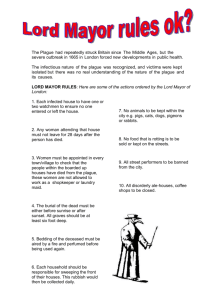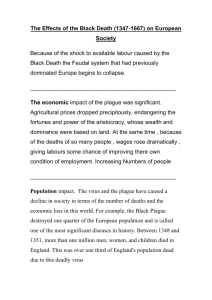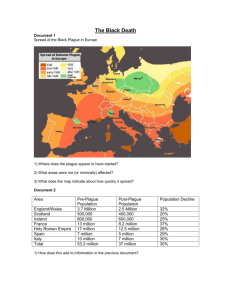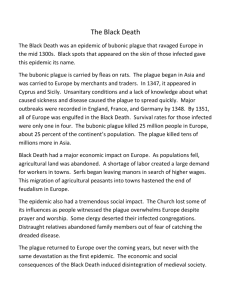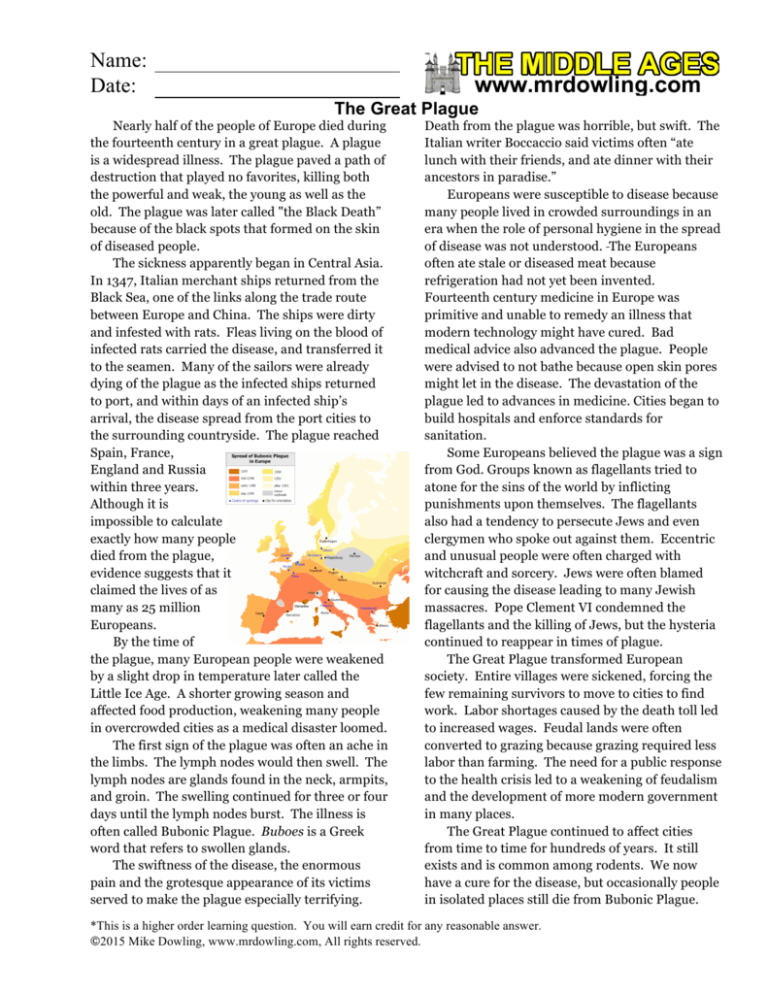
Name:
Date:
The Great Plague
Nearly half of the people of Europe died during
the fourteenth century in a great plague. A plague
is a widespread illness. The plague paved a path of
destruction that played no favorites, killing both
the powerful and weak, the young as well as the
old. The plague was later called "the Black Death”
because of the black spots that formed on the skin
of diseased people.
The sickness apparently began in Central Asia.
In 1347, Italian merchant ships returned from the
Black Sea, one of the links along the trade route
between Europe and China. The ships were dirty
and infested with rats. Fleas living on the blood of
infected rats carried the disease, and transferred it
to the seamen. Many of the sailors were already
dying of the plague as the infected ships returned
to port, and within days of an infected ship’s
arrival, the disease spread from the port cities to
the surrounding countryside. The plague reached
Spain, France,
England and Russia
within three years.
Although it is
impossible to calculate
exactly how many people
died from the plague,
evidence suggests that it
claimed the lives of as
many as 25 million
Europeans.
By the time of
the plague, many European people were weakened
by a slight drop in temperature later called the
Little Ice Age. A shorter growing season and
affected food production, weakening many people
in overcrowded cities as a medical disaster loomed.
The first sign of the plague was often an ache in
the limbs. The lymph nodes would then swell. The
lymph nodes are glands found in the neck, armpits,
and groin. The swelling continued for three or four
days until the lymph nodes burst. The illness is
often called Bubonic Plague. Buboes is a Greek
word that refers to swollen glands.
The swiftness of the disease, the enormous
pain and the grotesque appearance of its victims
served to make the plague especially terrifying.
Death from the plague was horrible, but swift. The
Italian writer Boccaccio said victims often “ate
lunch with their friends, and ate dinner with their
ancestors in paradise.”
Europeans were susceptible to disease because
many people lived in crowded surroundings in an
era when the role of personal hygiene in the spread
of disease was not understood. The Europeans
often ate stale or diseased meat because
refrigeration had not yet been invented.
Fourteenth century medicine in Europe was
primitive and unable to remedy an illness that
modern technology might have cured. Bad
medical advice also advanced the plague. People
were advised to not bathe because open skin pores
might let in the disease. The devastation of the
plague led to advances in medicine. Cities began to
build hospitals and enforce standards for
sanitation.
Some Europeans believed the plague was a sign
from God. Groups known as flagellants tried to
atone for the sins of the world by inflicting
punishments upon themselves. The flagellants
also had a tendency to persecute Jews and even
clergymen who spoke out against them. Eccentric
and unusual people were often charged with
witchcraft and sorcery. Jews were often blamed
for causing the disease leading to many Jewish
massacres. Pope Clement VI condemned the
flagellants and the killing of Jews, but the hysteria
continued to reappear in times of plague.
The Great Plague transformed European
society. Entire villages were sickened, forcing the
few remaining survivors to move to cities to find
work. Labor shortages caused by the death toll led
to increased wages. Feudal lands were often
converted to grazing because grazing required less
labor than farming. The need for a public response
to the health crisis led to a weakening of feudalism
and the development of more modern government
in many places.
The Great Plague continued to affect cities
from time to time for hundreds of years. It still
exists and is common among rodents. We now
have a cure for the disease, but occasionally people
in isolated places still die from Bubonic Plague.
*This is a higher order learning question. You will earn credit for any reasonable answer.
©2015 Mike Dowling, www.mrdowling.com, All rights reserved.
Name:
Date:
Fill in the Blanks
Europe was ravaged in the f__u__t__e__th century by the B__a__k D__a__h, a great s__c__n__ss that
killed nearly h____f of the people on the *c__n__i__e__t. The plague was transported by d__r__y, rat infested
s________ that traveled between C__n__r__l Asia and I__a__y. The plague first appeared in Europe in 13____,
but spread as far as E__g__a__d and R__s__ia by 1351.
The sickness was called the B__b__n__c Plague because it infected glands called l__m__h n__d__s.
Bubos is a Greek work that refers to s__o__l__n glands. Within three or four days of *i__f__c__i__n, a
victim’s lymph nodes would s__e__l and b__r__t. Plague victims often suffered a quick but agonizing death.
The Great Plague persisted because of the poor s__n__t__ry conditions in European cities. People often ate
s__a__e or d__s__a__ed meat and personal h__g__e__e was a priority for most people.
A group of religious
people called f__a__e__l__n__s believed the p__a__ue was a sign from God and tried to atone for the sins of
the world by inflicting p__n__s__m__n__s on t__e__s__l__es and others.
The Great Plague still e__i__ts and is common among r__d__n__s, but we now have a c______ and the
s__c__n__ss exists only in i__o__a__ed places.
Answer in complete sentences
1. Why was the Great Bubonic Plague also known as the Black Death?
2. What does Bubonic refer to?
3. Explain what Boccaccio meant when he said victims often “ate lunch with their friends, and ate dinner with
their ancestors in paradise.”
4. Why were the flagellants troublesome for many European cities suffering from the plague?
5. Explain how the Great Plague transformed Europe/
*This is a higher order learning question. You will earn credit for any reasonable answer.





